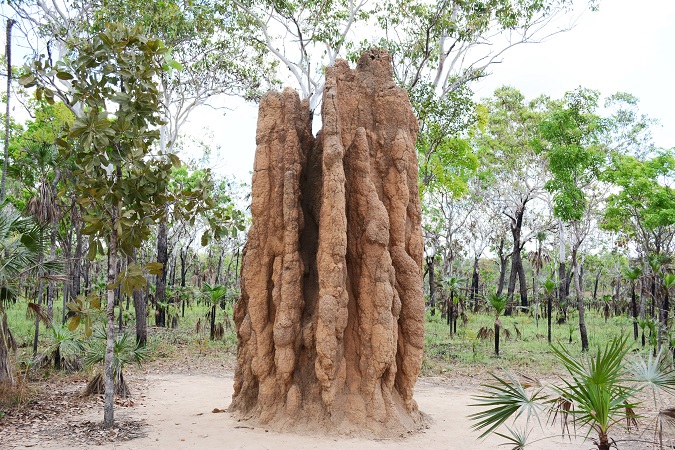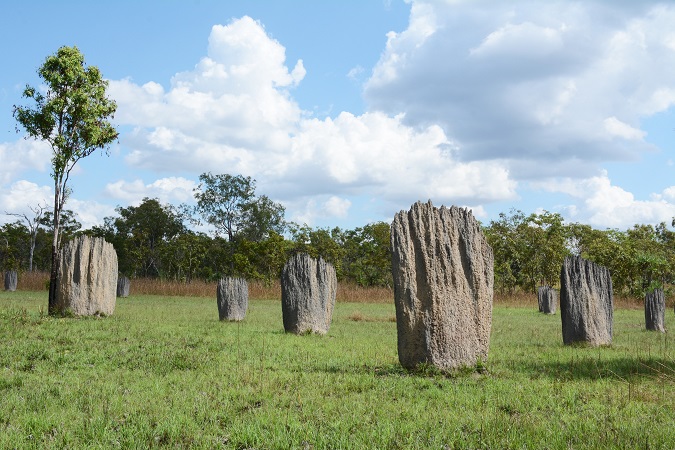
Explore the World of Termite Mounds in Northern Australia
Updated Apr 2022
If you travel anywhere in northern Australia, you will see termite mounds. Termite mounds are massive termite cities. Some are small, and some are gigantic. Together with rainforest and crocodiles, they are an iconic part of the landscape. Some reach a height of six metres with a population in the millions.
There are more than 350 species of termites in Australia. In addition to mound builders, some termites live in trees and many live underground where you will never see them. Likewise, you will probably never see any mound builders, as they are primarily nocturnal. However, the mounds themselves are conspicuous and fascinating to study.
Termite Society
Like ants and bees, termites are social insects that live in colonies. They are sometimes called white ants, but they are unrelated to ants.
The population of a termite mound could number in the millions. Like ants and bees, they have different castes to perform various functions. Like the queen bee, the queen termite does nothing except lay eggs. The eggs hatch into larvae, and the larvae will become one of three termite castes.
more photos below
Worker Termites
Like bees and ants, most of the population is made up of workers. They build the termite mound, forage for food, and look after the larvae.
Soldier Termites
The soldier termites have the responsibility for the defence of the termite mound. They have formidable mandibles that can cut or stab an intruder. They also have chemical weapons in the form of a toxic spray from special glands on their forehead. The spray can reach a distance of several centimetres.
Alates
Alates are a particular type of termite that has the role of mating and starting new colonies. Around the time of the first rain (the rainy season starts around Christmas time), millions of alates grow wings and leave the termite mound. They fly off in search of a mate from a different mound. Giant clouds of alates fill the air. This is a massive feast for birds and lizards, who consume most of them.
The few successful in mating will start a new colony and build a new mound. The female alate will become the queen of the new colony. They don’t get a message on the internet or a telephone call, so how do all the thousands of termite mounds know to release their alates simultaneously? They synchronize the release of their alates when the humidity reaches a certain level at the time of the first significant rainfall of the season.
Dead Termite Mounds
When the queen eventually dies, the whole colony dies with her. There is no replacement. However, queen termites live a long life. A queen termite can live close to 100 years, making it the longest-lived insect.
The Hooded Parrot and the Golden-shouldered Parrot dig into old termite mounds and nest in them. Therefore, these parrots are endemic to northern Australia. Some reptiles and mammals also burrow into ancient termite mounds to make a nest.
What do termites eat?
Different species of termites eat other food. For example, many eat dead grass, some eat things they find in the soil, and some eat wood.
Wood Eaters
Unfortunately, the wood-eating termites also eat houses. This is a significant problem in Australia as a termite infestation can destroy a house if not detected early. Keep in mind that most termites do not eat wood. In addition, most wood-eating termites do not build mounds.
Soil feeders
This type of termite feeds on organic matter that they find in the soil. They live underground and do not build mounds. Most people are entirely unaware of their existence.
Grass feeders
These termites feed on dry grass and dead plants. Most of the termite mounds you will see belong to this type of termite.
Cathedral Termite Mounds
The cathedral termites build the largest and most spectacular termite mounds. They are so named because their mounds resemble the mighty European cathedrals of the middle ages. Some are tall like skyscrapers and can be as much as six metres in height. Others are shorter and rounder but still massive. These large mounds take between 50 to 100 years to build.
The sides of the mound are not smooth. Instead, they have flutes (grooves), which create shadows. Inside these flutes, the air is cooler because it is in the shade. As the air in the flutes warms, it rises to the top and escapes, replaced by cooler air near the ground. It is an ingenious method of air conditioning.
Magnetic Termite Mounds
Although not as tall nor as impressive as the cathedral termite mounds, the mounds of the magnetic termite are more interesting. The structure is wide on two sides and very narrow on the other sides—sort of like the shape of a tombstone. A field of magnetic termite mounds resembles a graveyard but with much larger tombstones.
Magnetic termite mounds are built on a north-south axis. This means the sun will shine mainly on the narrow sides at the hottest part of the day, leaving the broader sides at a lower temperature.
Tree Termites


Left: Termite nest in a tree. Right: A covered walkway built by the termites down the tree’s trunk.
Some termites build their homes in the treetops. These termites eat the tree from the inside out, leaving the branches hollow. The most interesting thing about these termites is that they build a covered walkway down the tree’s trunk. Using this walkway, they can travel up and down the tree without being exposed to predators or the sun.
The aboriginal people make a musical instrument called the didgeridoo from branches that tree termites have hollowed out. Didgeridoos hollowed out by machinery are not authentic. Something to look for if you purchase one for a souvenir of Australia.
Summary
These are just a few of the hundreds of species of termites in Australia. You can’t help but notice them if you travel in the country’s north. The termite mounds are just one of many fascinating things to see on a tour of northern Australia.
Clothing for Termite Mounds
People travelling across northern Australia have a strange custom of putting clothing on termite mounds. So if you have an old shirt and hat that you no longer want, bring it with you to dress up a termite mound.



This is so cool. Not meaning the mound itself. I remember seeing Sir David Attinbough crawl into one in a documentariy he hosted. Did you try? Evelyn?
No, I did not go inside. I knocked on one but there was no answer.